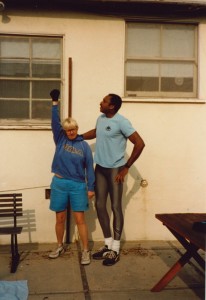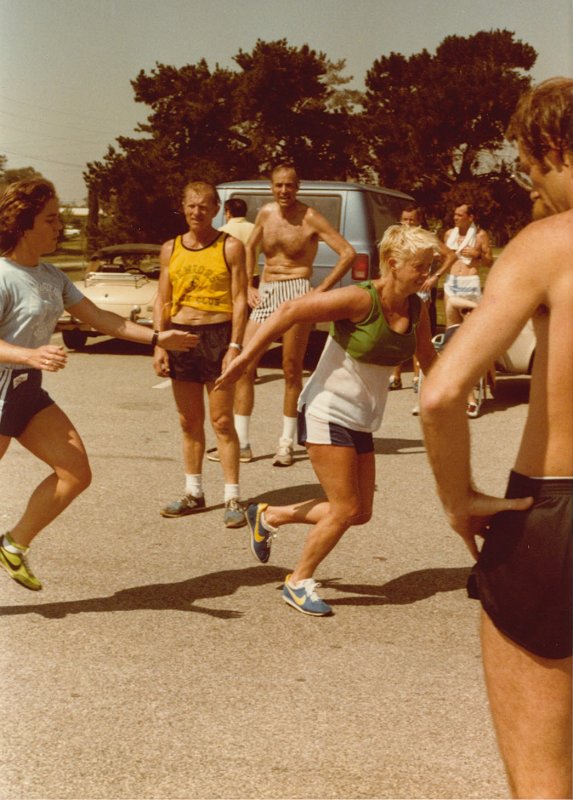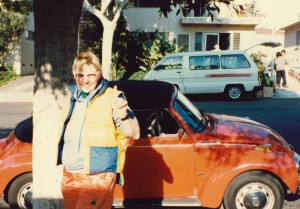Zan Knudson found me in 1976. She read about my autobiography, A Running Start: An Athlete, A Woman, in Publishers Weekly magazine and decided to track me down. Zan was one of the few women writing sports novels in America at that time, so she wanted to meet me. She went to a lot of track meets at UCLA looking for me and finally found someone who gave her my phone number. Zan and her life-long partner, May Swensen – America’s premier living poet at that time – wintered in Los Angeles each year. I went to meet Zan at their Westwood apartment. I had no clue she would teach me all the writing tips below.
Zan struck me as very odd, but bursting with writing energy, ideas, and projects. She intrigued me. Every winter when she and May returned to L.A., we got together for running, laughing, and tossing around writing ideas. I was a freelance sportswriter at the time, so some of her ideas ended up in print. By 1984, Zan and I were fine friends, and she was looking for a worthy reason to spend the whole Olympic year in L.A. She wanted to be here while the Games rose up around her that Summer. She suggested we document the new water exercise program I had just created. She was a genius at giving catchy names to things, so when she cooked up The Waterpower Workout book, I was in. That was our first book together. It is no longer in print, but I always count it as the book that created the market for the next book The Complete Waterpower Workout Book, which is still in print and the bestseller in its field after two decades. After that was Heal Your Hips: How To Prevent Hip Surgery – and What To Do If You Need It. By 2002, when I was writing Heal Your Knees, I realized I could go it alone. Zan had taught me how to write books.
Zan died in 2008, but even last week, when I sat down to write a book proposal for the second edition of Heal Your Hips, Zan was yelling in my ear giving me advice. Just as you can hear a good coach’s directions when you’re in the middle of a solo workout, so I could hear Zan’s bombastic instructions. She was always right; she always knew best. (Most of the time she did.)
Zan was told by her first editor to write under the name of R.R. Knudson since no one would buy sports books written by a woman in the 1970s. Now seems like a good time to share some of the things she taught me.
- Say it once, say it right, then don’t say it again. If I found myself starting to explain something, then the next sentence overlapped a little, I had to start over to get it right so nothing would be repeated.
- Every word counts. Get rid of every word that isn’t necessary.
- Have lots of light and counter space. Zan would put up a table in front of the window with the most light and spread all the chapters out where they could be seen. She wouldn’t allow anything else on the table or desk space but what we were writing.
- Don’t split infinitives. Sure most writers today do, but it isn’t grammatically correct. You don’t write “to clearly understand,” but “to understand clearly.” Zan didn’t want our writing to contribute to the decline of American grammar.
- Put “only” in the right place. Most people put the word “only” too early in the sentence when it should be immediately next to what it refers. Instead of, “he only wanted to see the giraffes,” it should read “he wanted to see only the giraffes.”
- Put things in the right order. I have edited many things written by other people, and this is what I correct the most. The document, no matter how long or how short must flow directly from one sentence to the next, not back and forth between topics. There should be no jolts of changing from one subject to the next.
- Lead the reader by the hand. Don’t assume the reader knows anything about your subject. Start at the beginning and define your terms. Build on the knowledge in small steps. Never take an unexpected leap to anything, even a new word, that you haven’t introduced or defined. Especially when organizing chapters of books, make sure that the last sentence in one chapter leads to the first sentence of the next chapter.
- Read it out loud. Read what you’ve written out loud so that you can feel if there are any awkward spots that disrupt the smooth flow of words. If there are, fix every single one of them until it reads smoothly.
- Don’t quit until every word is “perfick.” That was Zan’s motto.

Zan, always irreverent, imitates Tommie Smith’s black-gloved salute in the 1968 Olympic Games while Tommie himself patiently looks on, 1986
Lynda Huey, M.S., founder of CompletePT and Huey’s Athletic Network, is a former athlete and coach whose own injuries led her into the water to find fitness and healing. She was educated at San Jose State University where she starred on the track and field team during its golden years. Lynda is the author of four books on water exercise and water rehabilitation.



